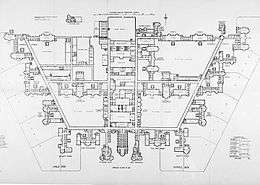Claybury Hospital
._Photogr_Wellcome_L0027374.jpg)
._Photogr_Wellcome_L0027373.jpg)


Claybury Hospital was a psychiatric hospital at Woodford Bridge in Essex. It was opened in 1893 making it the fifth London County Council Asylum.

History
Asylum was commissioned by the Middlesex Court of Magistrates in 1887, as the fourth Middlesex County Asylum.[1] The architect was George Thomas Hine (1841-1916), a specialist in designing asylums for the insane.
Claybury was situated on the brow of a hill, with the site incorporating around 50 acres (200,000 m2) of ancient woodland and 95 acres (380,000 m2) of open parkland, ponds, pasture and historic gardens. These had been designed in 1789 by the landscape architect Sir Humphry Repton for the owner, James Hatch, of what was then called the Claybury Estate. "Claybury" was the name given to a fictitious village in the stories of W. W. Jacobs, but is generally thought to be based on nearby Loughton, where Jacobs lived.
In 1889 the uncompleted building passed to the newly created London County Council which opened it in 1893. From 1893 to 1918 it was called Claybury Asylum, from 1918 to 1937 Claybury Mental Hospital, and from 1937 to its closure in 1995 Claybury Hospital.[1]
Closure
With the Care in the Community Programme and the inevitable decline in patient numbers from its peak of 4,000 patients, Claybury faced a difficult future. The NHS pressed for extensive demolition and maximum new build, whereas the Local Planning Authority and English Heritage argued for maximum retention of the historic buildings and restriction of new build to the existing footprint, in accordance with the Green Belt allocation in the Unitary Development Plan.
A 60-day Public Inquiry was held in 1997 and the Council/English Heritage position was accepted. The hospital was shut down and converted into luxury flats called Repton Park by Crest Nicholson, working closely with English Heritage and the London Wildlife Trust.
Notable Patients
- Thomas Hennell, a British artist, who underwent a prolonged schizophrenic episode from 1932 to 1935. He was detained at St John's Hospital in Stone, the Maudsley Hospital in London, and finally at Claybury, Essex.[2]
Ghosts
There have been many reported ghost sightings at the site, (such as tall men) both while it was still a mental hospital and more recently as the Repton Park development . In Rodinsky's Room, a book by Iain Sinclair and Rachel Lichtenstein about David Rodinsky, they mark the tower at L. C. C. Claybury Mental Hospital, as the "fixed compass-point from which Rodinsky drew his circuits of London. All his maps were based on that sightline" (Dark Lanthorns 32). As a result of Lichtenstein's research, we learn that this is the hospital where Rodinsky's sister, Bessie, was sectioned, a fate that would befall Rodinsky himself when the authorities forced him out of his home on Princelet Street, setting in motion a series of events that led to his eventual entry into a mental institution in Surrey (Long Grove Hospital), where he later died of heart failure.
See also
References
- 1 2 Claybury Asylum, Woodford, Essex: a dining room (?). Photograph by the London & County Photographic Co., [1893?], 1893-01-01, retrieved 2016-08-24
- ↑ Hennell, Thomas (1935-01-01), Visions of a schizophrenic: the trunk of an ancient tree is consumed by fire, while a cross stands firm. Drawing byT. Hennell, ca. 1935, retrieved 2016-08-24
- "Claybury Asylum, Woodford Green". TheTimeChamber. TheTimeChamber. Retrieved 6 December 2011.
Coordinates: 51°36′11″N 0°04′07″E / 51.6031°N 0.0687°E